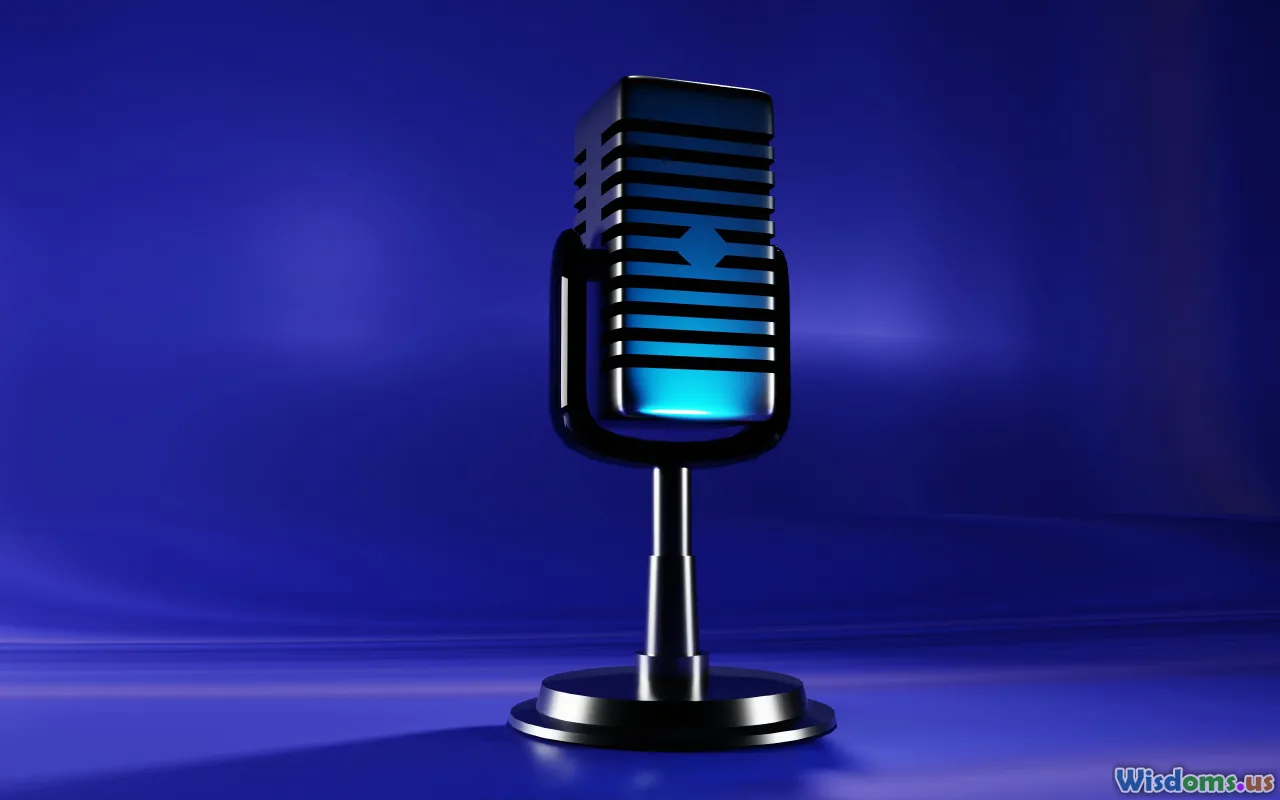
Simple Daily Habits To Improve Your Vocal Delivery Fast
13 min read Boost your vocal delivery with simple daily habits designed for fast, noticeable improvement—perfect for speakers, singers, educators, and anyone aiming for greater vocal impact. (0 Reviews)
Simple Daily Habits To Improve Your Vocal Delivery Fast
The power of your voice isn't just in the words you choose, but in how you deliver them. Whether you're a professional speaker, a teacher, a podcaster, or simply looking to make a better impression in everyday conversations, mastering vocal delivery can unlock doors and open new opportunities. But making dramatic changes doesn’t require years of training—often, small, intentional habits practiced daily can transform your voice in remarkable ways. Let’s dive into proven techniques and quick daily practices that have helped many achieve clearer, more compelling vocal delivery.
Breath Control: The Foundation of Powerful Speech

It all starts with how you breathe. Efficient breath control gives your voice strength, stamina, and a natural resonance. Consider this: actors like Morgan Freeman and speakers like Barack Obama rely heavily on diaphragmatic breathing for their commanding stage presence.
How to Build the Habit
- Diaphragmatic Breathing: Place one hand on your stomach and the other on your chest. Breathe in through your nose and let your stomach expand. Avoid letting your chest rise. Practice this for five minutes every morning.
- Consistent Practice: Set a reminder during work breaks to check your breathing. Proper breath ensures each sentence you utter carries energy and doesn’t trail off.
Example in Action
Before giving a keynote, Apple’s Steve Jobs engaged in breathing exercises to stay calm and project his voice across large auditoriums⎯one reason his public speeches resonated globally.
Articulation Drills: Make Every Word Count

Mumbling or slurred speech undermines even the best ideas. Articulation exercises train your speaking muscles just as squats build your legs. They help your audience catch every word with clarity.
Simple Daily Exercises
- Tongue Twisters: Try “Unique New York” or “Red Leather, Yellow Leather” each morning and evening. Start slow, focus on precision, then pick up the pace as you improve.
- Over-Enunciation: Read a page of text, deliberately exaggerating the movement of your lips and tongue. It may feel silly, but actors and news anchors swear by it.
Real-World Results
When British actor Benedict Cumberbatch preps for stage roles, he spends up to 30 minutes on articulation drills to ensure every audience member, even in the back rows, hears each syllable.
Hydration: Lubricate and Protect Your Vocal Cords

Your vocal cords are delicate membranes that vibrate thousands of times a day. Dehydration makes them stiff and prone to damage; a well-hydrated voice is clearer and more resilient.
Actionable Tips
- Keep Water Handy: Aim for consistent sips instead of occasional gulps. A good target is 8 glasses (about 2 liters) daily.
- Avoid Excess Caffeine and Alcohol: Both dry out your throat. Swap that third cup of coffee for herbal tea. Performers like Adele travel with water bottles to protect their vocal cords, and it's a habit you can adopt, too.
A Fact to Remember
Studies published in the Journal of Voice show that even mild dehydration can lead to increased vocal effort and a hoarse tone.
Warm-Up and Cool-Down: The Vocalist’s Routine

Professional singers and speakers never skip their vocal warm-up. Just five minutes can prevent strain and improve your dynamic range.
Warm-Up Routine (5 Minutes)
- Lip Trills: Blow air through closed lips. This vibrates the vocal cords gently and increases flexibility.
- Sirens: Glide your voice up and down your range on a "woo" or "nee" sound.
- Humming: Hum simple melodies with relaxed lips. It benefits resonance and control.
Cool-Down Practices
After a long call or speech, unwind with gentle humming or soft sighs, hydrating again to aid recovery. Think of this as the vocal equivalent of stretching after a run.
Why It Works
Voices are muscles. Just as athletes warm up to avoid injury, singers like Beyoncé meticulously warm-up and cool down to sustain their vocal health during demanding tours.
Posture and Body Language: Amplify Your Presence

How you hold your body affects your breath and your audience’s perception. An upright posture frees the diaphragm, opens the chest, and boosts vocal projection.
Developing the Habit
- Shoulder Rolls and Chin Tucks: Begin each day with these movements to release neck and back tension.
- Speak While Standing: When on the phone or practicing speeches, stand up with feet shoulder-width apart, shoulders relaxed, and head up.
Example
Renowned TED Talk presenters invariably adopt tall, open postures—think of Simon Sinek or Amy Cuddy—commanding attention long before their first word.
Daily Read-Aloud: Train Clarity and Expressiveness

Reading aloud is an old but gold technique. It hones pronunciation, expression, and modulation while exposing tricky habitual errors.
How to Implement
- Read a news article, a page of a novel, or even your work emails out loud for 10 minutes a day.
- Record yourself occasionally to track improvements and discover which phrases you find challenging or monotonous.
A Compelling Example
Morgan Freeman, before his career breakthrough, would read newspapers aloud to practice vocal control and expressive narration—a foundation of his iconic style.
Mindful Pausing: Harnessing the Power of Silence

Strategic pauses can add emphasis, clarity, and emotional power to your words. Overused filler words like “um” or “like” can be replaced with intentional silence.
Practical Techniques
- While discussing ideas, consciously insert a pause after key points. Let your audience absorb your message.
- Set endpoints in your speech—after a statistic, before a new idea—to use a breath as a ‘punctuation mark’.
Insight
Barack Obama’s measured speech is famous for well-placed pauses—often making his statements feel profound and memorable.
Volume and Pitch Variation: Keep Listeners Engaged

Monotone delivery loses listeners fast. Training your voice to move across pitch and adjust volume can be easily incorporated into your day.
Smart Practice
- Pick a simple story and retell it, varying your pitch for emphasis (raise your voice for excitement, lower it for seriousness).
- Practice projecting your voice across different environments—try speaking clearly to a friend at the other end of a long room.
Impactful Fact
A study by the University of Illinois found that speakers who modulated their voice kept audiences’ attention up to 33% longer than those with monotone delivery.
Eliminating Fillers: Speak with Confidence

Filler words dilute impact. With practice, you can train your brain to embrace pauses rather than default to “uh”, “um”, or “you know”.
Daily Habit
Set aside five minutes to record yourself answering random questions (pull prompts from online lists). Listen closely for unnecessary fillers and track your improvement.
Peer Example
Podcasters like Sarah Koenig (Serial) and Ira Glass (This American Life) meticulously edit and rehearse to minimize fillers, enhancing authority and listenability.
Feedback and Reflection: Accelerate Improvement

Improvement happens fastest when you’re aware of your progress. Seeking feedback, even from yourself, helps refine your voice quickly.
Quick Methods
- Use smartphone recordings to assess your tone, clarity, and rhythm. Note one habit per week to improve upon.
- Request constructive feedback from trusted friends or colleagues, focusing on specific aspects (pace, clarity, warmth).
Example
Many broadcasters credit regular air checks—a review of their own broadcasts—with catching subtle patterns and refining delivery.
Diet and Lifestyle: Subtle Factors with Big Impact

What you eat (and don’t eat) can shape your daily vocal quality. Spicy foods, late-night dinners, or smoking can cause acid reflux or irritation. Instead, a balanced diet supports vocal resilience.
Tips
- Avoid dairy before important talks (it can thicken mucus for some people).
- Opt for light, balanced meals and avoid yelling or harsh throat clearing.
- Get enough sleep: fatigue often leads to sloppy articulation and reduced vocal projection.
Noteworthy Example
Public speakers and actors, such as Hugh Jackman, often credit a clean, balanced lifestyle for sustained peak performance during grueling tours.
Committing to even a few of these habits each day brings you closer to a voice that captures attention, inspires trust, and communicates your message with punch and clarity. Little tweaks—better breathing, sharper enunciation, more mindful pauses—yield fast results, turning everyday conversations or presentations into moments of genuine connection. Your best voice is within reach; greet every day as another step toward mastering it.
Rate the Post
User Reviews
Popular Posts
















